Story By John Murray
The news reached Waterbury Mayor Neil O’Leary on August 8th while he was vacationing on the coast of Maine with his family. The city of Waterbury had just won a fierce competition for a multi-million-dollar grant from the U.S. Department of Transportation’s RAISE program. It was an electric moment for both Waterbury and the longest continuously serving mayor in city history.
“I’m so excited about this”, O’Leary said. “Waterbury’s legacy of industry is no longer viable. We are taking dozens of dilapidated brownfields and cleaning them up and redeveloping them. Waterbury is on the move.”
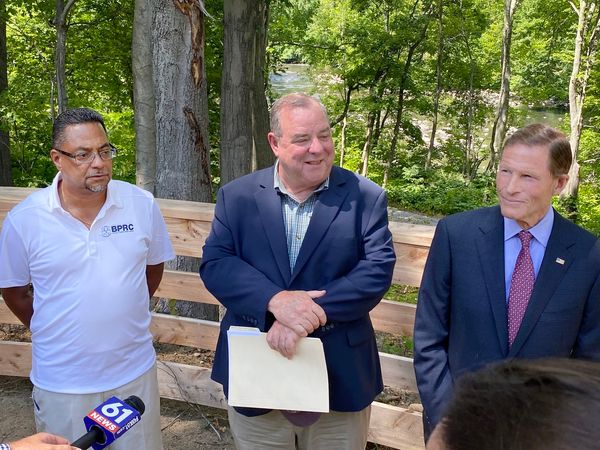
Waterbury Mayor Neil O’Leary, middle, during a press conference August 15th, with U.S. Senator Richard Blumenthal, right, and State Representative Geraldo Reyes Jr. |
The $23 million RAISE Grant is for the second phase of the WATER Project, an ambitious and visionary effort to reimagine portions of downtown Waterbury nestled along the Naugatuck River. Portions of the $28 million (Waterbury kicked in an additional $5 million as project buy-in) will be used to;
• Renovate the West Main Street corridor from the Green to Route 8 (photograph at the top)
• Build a new waterfront park on a parcel of land along Jackson Street between the train station and the river, all be connected by a pedestrian bridge

This vacant property will be transformed into a waterfront park along Jackson Street. |
• Build Phase #2 of the Naugatuck River Greenway through Waterbury, a 2.3 mile stretch from the Eagle Street Bridge in the South End to West Main Street
• Install electric car charging stations in the train station parking lot
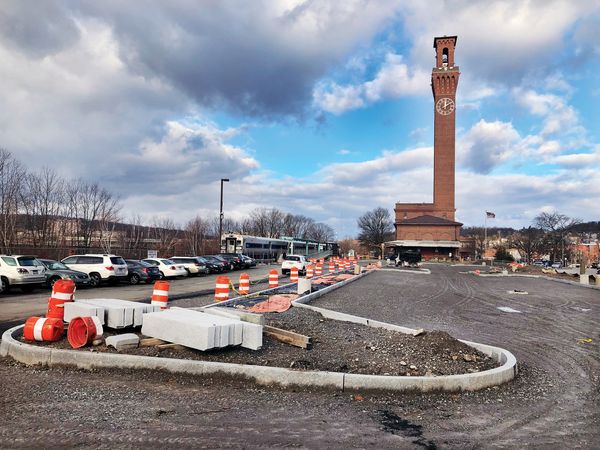
In the past two years the train station parking lot was completely renovated. |
There are other major projects underway that include;
• The completion of the first phase of the greenway from Platts Mills Road to the Eagle Street Bridge scheduled to be completed and opened in late November 2022.
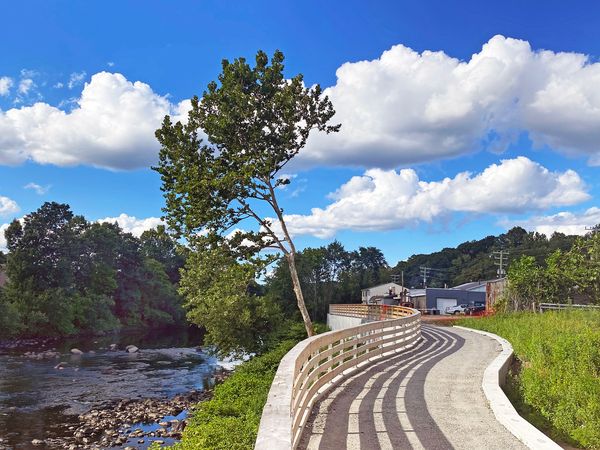
Phase #1 of the greenway will be completed in November 2022 |
• The construction of a new baseball field and playground on Mill Street on the site of the former Nova Dye factory. Ground breaking is scheduled for October 2022.
• Build greenhouses at the Brass City Harvest food hub across the street from the ball field on Mill Street. Extend the complex all the way down to South Main Street and build a market and café for the public.
• Complete demolition of the Anamet site that will clear 16 acres of space for development right along the Naugatuck River in the heart of the South End.

The demolition of Anamet on South Main Street is in the home stretch. |
• Demolition and clean-up of the former Waterbury Button Company in the South End
“Children have been walking to school past these decrepit factories for years,” O’Leary said. “That is changing. We’re creating space for children and families to enjoy recreation.”
When Waterbury won the TIGER Grant in 2014 Mayor O’Leary called it his “aha moment”. He said it was a game changer because once the federal government invested in a project they usually fund it to completion.
The $23 million RAISE Grant is the second “aha moment” for O’Leary, who has become a national leader in transforming brownfields into reusable and productive space.
“Waterbury leads the nation in brownfield remediation,” U.S. Senator Richard Blumenthal said. “Trillions of dollars is being invested all around the country right now, and what Waterbury is doing is what the nation will look like – taking vacant polluted properties and cleaning and redeveloping them.”

Connecticut’s two U.S. Senators, Richard Blumenthal, left, and Chris Murphy, helped muscle the RAISE Grant through the highly competitive funding process. |
There are so many projects underway right now in Waterbury it’s staggering. On August 8th, before the money had been secured, U.S. Senator Chris Murphy and U.S. Congresswoman Jahana Hayes toured sites through Waterbury which were at various stages of development. As champions of the project in Washington D.C., Murphy and Hayes wanted to see firsthand how all the components fit together.
“Waterbury is asking for a lot of money ($30 million),” Murphy said, “but the city has done its homework and told their story well. The city has a vision and a plan. Awarding a RAISE Grant after the TIGER Grant is very attractive to the Feds.”
Hayes grew up in Waterbury and said she was thrilled at the transformation underway in the city.

Congresswoman Jahana Hayes was instrumental in championing the WATR Project during the review and funding process in Washington D.C.. |
“People who live here deserve environmental justice,” Hayes said. “I’m so grateful to see everything happening here. It’s exciting.”
The U.S. Government defines environmental justice, “as the fair treatment and meaningful involvement of all people, regardless of race, color, national origin, or income, with respect to the development, implementation, and enforcement of environmental laws, regulations, and policies.”
This goal will be achieved when everyone enjoys: he same degree of protection from environmental and health hazards, and equal access to the decision-making process to have a healthy environment in which to live, learn, and work.
President Joe Biden announced last year that he wanted environmental justice considered in every policy in his administration. Waterbury has pounced on the initiative.
“The city of Waterbury has made a strong case for the RAISE Grant,” Hayes said. “Everything is well documented.”
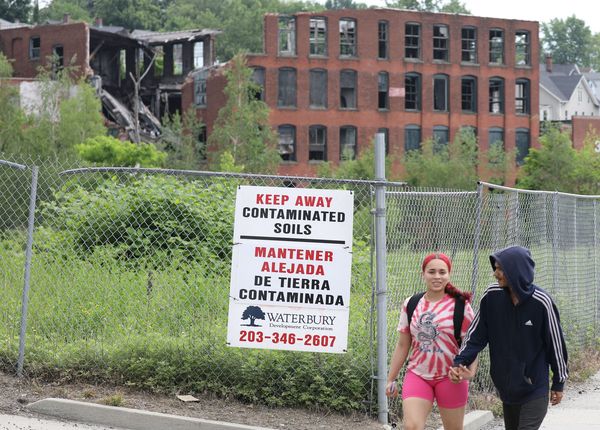
An entire generation of residents in the South End have walked and driven past the crumbling Waterbury Button Company. Waterbury has secured funding to demolish it. |
State Representative Geraldo Reyes Jr. joined Mayor O’Leary and Senator Blumenthal on a tour of the various projects in the city on August 15th. When the men stopped at the new park nearing completion across from the old Howard Johnson’s on South Main Street, they were met by several members of the press and they answered questions.
Reyes grew up in the South End and said he is astonished in the transformation of the Naugatuck River.
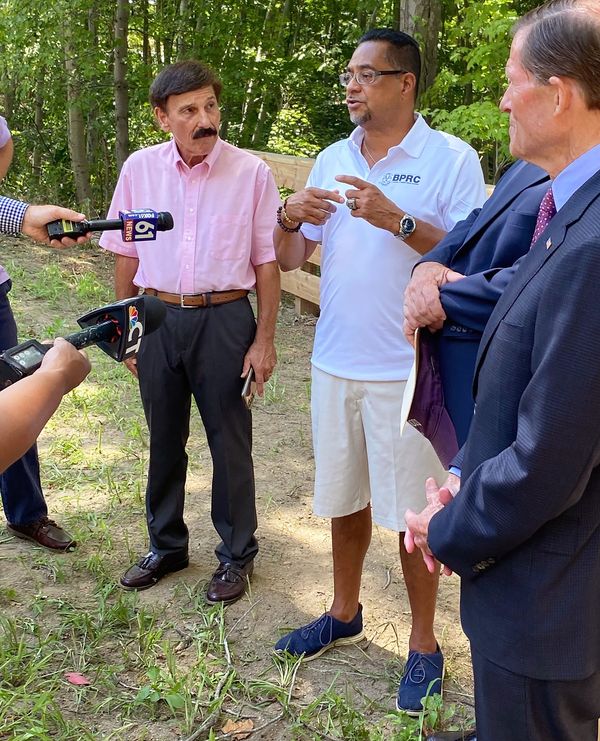
Geraldo Reyes Jr. has been in the State Legislature for seven years and is credited with strengthening Environmental Justice Laws in Connecticut. |
“We used to play down by the river when it ran green and yellow with dye from the factories,” Reyes said. “I’ve already brought my grandson down here to look at the greenway and the river. People will come from all over the state to enjoy this.”
O’Leary envisions fisherman up and down the Naugatuck River in Waterbury, two new beautiful parks, a baseball field and enormous opportunity for development.
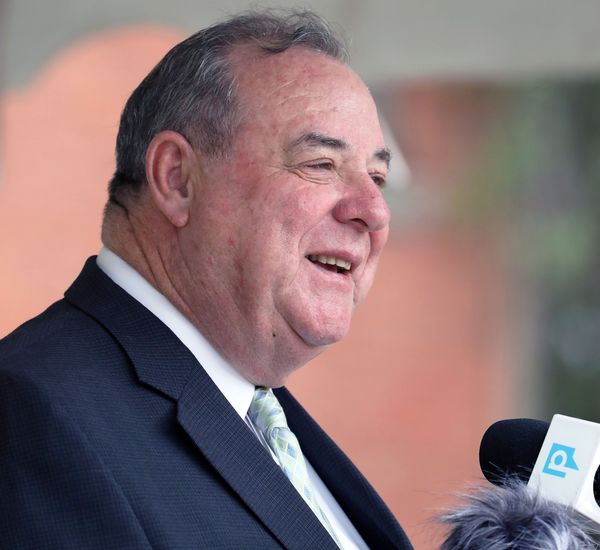
Years of brownfield remediation has led Waterbury Mayor Neil O’Leary to being nationally recognized for his effectiveness at securing funds and redeveloping sites. |
“We’re trying to clean up the city and improve the quality of life,” O’Leary said.
And for a city founded at the intersection of seven waterways it is poetic to call all these changes the WATER Project.
For two hundred years the Naugatuck River was a glorified toilet for industry and city residents turned their backs to it. Nature has healed the scars and now the community is turning towards the river for its future.
Waterbury has come full circle. •
(Subscribe to The Brass File to get it e-mailed free to your in-box by clicking on the link at the bottom of this page. Thank you.)

